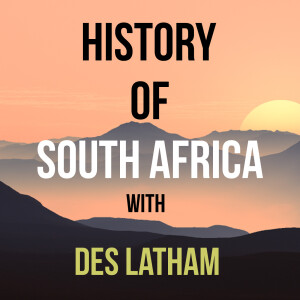
History of South Africa podcast
History

Episode 45 – The ancient people of the Orange River islands, the Namaqualand Korana and the “Bastaards”
 2021-12-19
2021-12-19
Download
Right click and do "save link as"
This is episode 45 and it’s time to turn our attention to Namaqualand.
This is an area which is not spoken of very often, the wild northern frontier where bandits rode oxen and escaped slaves, white ex-soldiers and black clans joined forces – or fought each other.
The brigands and Badlands here are exotic to say the least as you’re going to hear. Folks fixate on the tales from the eastern Cape frontier for good reason that’s true. And yet, much of the rich history of southern Africa encompasses the Orange River and its tributaries as well as the Namaqualand, the Karoo, the mystical and mythical geography lending beauty to what was an extraordinarily dangerous period in the last quarter of the 18th Century.
As you know by now, the area known as the Namaqualand was generally referred as the home of the Little Namaqua or Klein Namaqua. Great Namaqualand was the home of the Great Namaqua and was across the Orange River – today known as Namaland.
The first Europeans to settle in Namaqualand arrived in the 1750s – but before them ivory and other hunters had passed through regularly. By February and March of 1750, Jan Overholster, Jan Meyer and Jan Venter had registered loan farms here which they called Lieliefontein and Groene Rivier.
One of the dialects of the Einiqua was spoken by the people of the Namynkoa who lived along the rivers – their riverine lifestyle made them distinct from the other people of the region although they were pastoralists who ate fish and river shellfish amongst other foods. Most other Khoe away from the River were purely pastoralists.
Further east, heading deeper into the interior, lived the Korana groups who could be found in the vicinity of Kheis. They were the Kouringeis or Little Korana, otherwise known as the Hootstanders or Proud People.
But a hundred years earlier in 1779 trekboers who had arrived in Namaqualand were married to local Khoe women and this union created another group - the "Bastaards".
view more
This is an area which is not spoken of very often, the wild northern frontier where bandits rode oxen and escaped slaves, white ex-soldiers and black clans joined forces – or fought each other.
The brigands and Badlands here are exotic to say the least as you’re going to hear. Folks fixate on the tales from the eastern Cape frontier for good reason that’s true. And yet, much of the rich history of southern Africa encompasses the Orange River and its tributaries as well as the Namaqualand, the Karoo, the mystical and mythical geography lending beauty to what was an extraordinarily dangerous period in the last quarter of the 18th Century.
As you know by now, the area known as the Namaqualand was generally referred as the home of the Little Namaqua or Klein Namaqua. Great Namaqualand was the home of the Great Namaqua and was across the Orange River – today known as Namaland.
The first Europeans to settle in Namaqualand arrived in the 1750s – but before them ivory and other hunters had passed through regularly. By February and March of 1750, Jan Overholster, Jan Meyer and Jan Venter had registered loan farms here which they called Lieliefontein and Groene Rivier.
One of the dialects of the Einiqua was spoken by the people of the Namynkoa who lived along the rivers – their riverine lifestyle made them distinct from the other people of the region although they were pastoralists who ate fish and river shellfish amongst other foods. Most other Khoe away from the River were purely pastoralists.
Further east, heading deeper into the interior, lived the Korana groups who could be found in the vicinity of Kheis. They were the Kouringeis or Little Korana, otherwise known as the Hootstanders or Proud People.
But a hundred years earlier in 1779 trekboers who had arrived in Namaqualand were married to local Khoe women and this union created another group - the "Bastaards".
More Episodes
012345678910111213141516171819
Create your
podcast in
minutes
- Full-featured podcast site
- Unlimited storage and bandwidth
- Comprehensive podcast stats
- Distribute to Apple Podcasts, Spotify, and more
- Make money with your podcast
It is Free
- Privacy Policy
- Cookie Policy
- Terms of Use
- Consent Preferences
- Copyright © 2015-2024 Podbean.com





